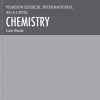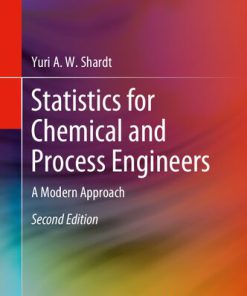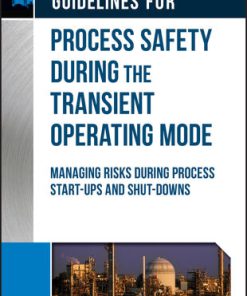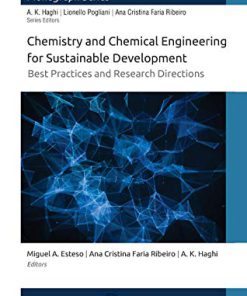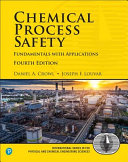Handbook for Chemical Process Research and Development 2nd Edition by Wenyi Zhao 1032259272 9781032259277
$50.00 Original price was: $50.00.$25.00Current price is: $25.00.
Handbook for Chemical Process Research and Development 2nd Edition by Wenyi Zhao – Ebook PDF Instant Download/Delivery: 1032259272, 9781032259277
Full download Handbook for Chemical Process Research and Development 2nd Edition after payment
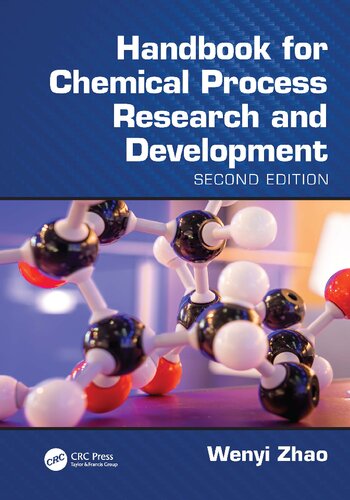
Product details:
ISBN 10: 1032259272
ISBN 13: 9781032259277
Author: Wenyi Zhao
This fully updated second edition reflects the significant changes in process chemistry since the first edition and includes more common process issues such as safety, cost, robustness, and environmental impact. Some areas have made notable progress such as process safety, stereochemistry, new reagents and reagent surrogates. Forty years ago there were few process research and development activities in the pharmaceutical industry, partly due to the simplicity of drug molecules. With increasing structural complexity especially the introduction of chiral centers into drug molecules and stricter regulations, process R&D has become one of the critical departments for pharmaceutical companies. Features: This unique volume now in its second edition is designed to provide readers with an unprecedented strategy and approach which will help chemists and graduate students develop chemical processes in an efficient manner. Promotes an industrial mindset concerning safety and commercial viability when developing methods. The author discusses development strategies with case studies and experimental procedures. Focuses on mechanism-guided process development which provides readers with practical strategies and approaches. Addresses more common process issues such as safety, cost, robustness, and environmental impact. This book provides a new direction for scientists, researchers, and students in materials science and polymer chemistry who seek to better understand the chemistry behind conducting polymers and improve their performance for use in advanced energy applications.
Handbook for Chemical Process Research and Development 2nd Table of contents:
Chapter 1 Reaction Solvent Selection
1.1 Ethereal Solvents
1.1.1 Cyclopentyl Methyl Ether
1.1.1.1 Brook Rearrangement
1.1.1.2 N-Alkylation Reaction
1.1.2 Tetrahydrofuran
1.1.2.1 Grignard Reagent Formation
1.1.2.2 Bromination of Ketone
1.1.3 2-Methyl Tetrahydrofuran
1.1.3.1 Control of Impurity Formation
1.1.3.2 Enhancing Reaction Rate
1.1.3.3 Improving Layer Separation
1.1.4 Methyl tert-Butyl Ether
1.1.4.1 Chlorination Reaction
1.1.4.2 Darzens Reaction
1.1.5 Diethoxymethane and Dimethoxyethane
1.2 Protic Solvents
1.2.1 Methanol as a Solvent
1.2.1.1 Leak of Palladium Catalyst
1.2.1.2 Side Product Formation
1.2.1.3 Palladium-Catalyzed Methylation Reaction
1.2.2 Ethanol as a Solvent
1.2.2.1 Catalytic Reduction of Diaryl Methanol
1.2.2.2 SN2 Reaction
1.2.3 2-Propanol as a Solvent
1.2.3.1 Reaction of Acyl Hydrazine with Trimethylsilyl Isocyanate
1.2.3.2 Classical Resolution of Racemic Acid
1.2.3.3 Nickel-Catalyzed Addition Reaction
1.2.4 1-Pentanol
1.2.5 Ethylene Glycol
1.3 Water as Reaction Solvent
1.3.1 Iodination Reaction
1.3.2 Synthesis of Quinazoline-2,4-dione
1.3.3 Synthesis of Pyrrolocyclohexanone
1.3.4 Synthesis of Thiourea
1.3.5 Synthesis of Amide
1.3.6 Synthesis of 1,3/1,4-Diketones
1.4 Non-Polar Solvents
1.4.1 Condensation of Ketone with tert-Butyl Hydrazine Carboxylate
1.4.2 Acid-Catalyzed Esterification
1.5 Polar Aprotic Solvents
1.5.1 Acetone as a Solvent
1.5.1.1 Michael Addition Reaction with Acetone Cyanohydrin
1.5.1.2 SN2 Alkylation Reaction
1.5.1.3 Multi-Component Reactions
1.5.1.4 Amidation Reaction
1.5.2 Acetonitrile as a Solvent
1.5.2.1 Intramolecular Michael Addition Reaction
1.5.2.2 Synthesis of Imidazolines
1.5.2.3 Synthesis of α-Alkylated Ketones
1.5.2.4 Chlorosulfonylation Reaction
1.5.3 N,N-Dimethylformamide as a Solvent
1.5.3.1 Preparation of Alkyl Aryl Ether
1.5.3.2 Preparation of Bisaryl Ether
1.6 Halogenated Solvents
1.6.1 Dichloromethane
1.6.1.1 Reaction with Pyridine
1.6.1.2 Synthesis of Benzo[d]isothiazolone
1.6.2 1,2-Dichloroethane
1.6.3 Trifluoroacetic Acid
1.6.4 (Trifluoromethyl)benzene
1.6.5 Hexafluoroisopropanol
1.6.5.1 Selective Oxidation of Sulfide
1.6.5.2 Cycloaddition Reaction
1.7 Carcinogen Solvent
1.8 Other Solvents
1.8.1 DW-Therm
1.8.2 Dowtherm A
1.8.2.1 Synthesis of 6-Chlorochromene
1.8.2.2 Conrad–Limpach Synthesis of Hydroxyl Naphthyridine
1.8.2.3 Conrad–Limpach Synthesis of Quinolone
1.8.3 Polyethylene Glycol
1.8.4 Propylene Glycol Monomethyl Ether
1.8.5 Sulfolane
1.8.5.1 Bromination/Esterification
1.8.5.2 Fluorine-Exchange Reaction
1.8.6 Ionic Liquids
1.9 Mixture of Solvents
1.9.1 Aldol Condensation Reaction
1.9.2 Visible-Light Mediated Redox Neutral Reaction
1.10 Solvent-Free Reaction
Chapter 2 Reagent Selection
2.1 Inorganic Base
2.1.1 Sodium Bicarbonate
2.1.2 Potassium Carbonate
2.1.2.1 Boc Protection of Amino Group
2.1.2.2 Ring-Opening Iodination
2.1.3 Sodium Hydride
2.1.3.1 SN2 Reaction
2.1.3.2 Addition/Elimination Reaction
2.1.3.3 Nucleophilic Addition Reaction
2.1.4 LiOH/H2O2 Combination
2.1.4.1 Hydrolysis of Chiral Pentanoate
2.1.4.2 Hydrolysis of Chiral Propanoate
2.1.4.3 Hydrolysis of Chiral Amide
2.2 Organic Base
2.2.1 Trialkylamine
2.2.1.1 Diisopropylethylamine
2.2.1.2 Triethylamine
2.2.2 Imidazole
2.2.3 2,6-Dimethylpiperidine
2.2.4 2-(N,N-Dimethylamino)pyridine
2.2.5 Metal Alkoxide Base
2.2.5.1 Potassium tert-Pentylate
2.2.5.2 Lithium tert-Butoxide
2.2.5.3 Potassium tert-Butoxide
2.2.5.4 Potassium Trimethylsilanoate
2.2.5.5 Combination of Potassium tert-Butoxide with tert-Butyllithium
2.2.5.6 Sodium Methoxide
2.3 Reagents For Amide C(O)−N Bond Formation
2.3.1 CDI-Mediated Amide Formation
2.3.1.1 Preparation of Nicotinic Acid Amide
2.3.1.2 Preparation of Ureas
2.3.2 Thionyl Chloride-Mediated Amide Formation
2.3.2.1 Tetramethylurea-Catalyzed Acid Chloride Formation
2.3.2.2 N-Sulfinylaniline-Involved Amide Preparation
2.3.3 Boc2O-Mediated Amide Formation
2.3.4 Schotten–Baumann Reaction
2.3.5 Other Amide Formation Methods
2.3.5.1 Copper (II)-Catalyzed Transamidation
2.3.5.2 Cross-Coupling between Acyltrifluoroborates and Hydroxylamines
2.3.5.3 Catalytic Aminolysis of Ester
Chapter 3 Various Reagent Surrogates
3.1 Ammonia Surrogates
3.1.1 Ammonium Hydroxide
3.1.2 Ammonium Acetate
3.1.2.1 Condensation with β-Keto Amide
3.1.2.2 Condensation with Cyclohexanones
3.1.2.3 Consecutive Reductive Amination Reactions
3.1.3 Ammonium Chloride
3.1.4 Hydroxylamine Hydrochloride
3.1.4.1 Reductive Amination
3.1.4.2 Aromatization
3.1.5 O-Benzylhydroxylamine
3.1.6 Hydroxylamine-O-Sulfonic Acid
3.1.6.1 SN2 Reaction with Sulfinate
3.1.6.2 Reaction with Boronic Acid
3.1.7 Hexamethylene Tetramine
3.1.8 Acetonitrile
3.1.9 Chloroacetonitrile
3.1.10 tert-Butyl Carbamate
3.1.11 Diphenylmethanimine
3.1.12 α-Amino Acids
3.1.12.1 Glycine Hydrochloride
3.1.12.2 2,2-Diphenylglycine
3.1.13 Silylated Amines
3.1.14 Allylamines
3.1.15 Isoamyl Nitrite
3.1.16 1,2-Benzisoxazole
3.2 Carbon Monoxide Surrogates
3.2.1 N-Formylsaccharin
3.2.2 Paraformaldehyde
3.2.3 Molybdenum Carbonyl
3.2.4 Phenyl Formate
3.2.5 Benzene-1,3,5-Triyl Triformate (TFBen)
3.2.6 Formic Acid
3.3 Carbon Dioxide Surrogates
3.4 α-Hydroxysulfonates as Aldehyde Surrogates
3.4.1 Oxidation of Aldehyde to Acid
3.4.2 Reductive Amination
3.4.3 Diels–Alder Reaction
3.4.4 Strecker Reaction
3.4.5 Transaminase DKR of Aldehyde
3.4.6 Reduction of Aldehyde to Alcohol
3.5 Sulfur Dioxide Surrogate
3.5.1 Synthesis of Sulfones
3.5.2 Synthesis of Sulfoxides
3.5.3 Synthesis of Sulfonamides
3.6 Miscellaneous Surrogates
3.6.1 Methyl Iodide Surrogate
3.6.2 Cyanide Surrogates
3.6.2.1 2-Methyl-2-Phenyl Malononitrile (MPMN)
3.6.2.2 2-Cyanoisothiazolidine 1,1-Dioxide
3.6.3 Ethylene Surrogates
Chapter 4 Modes of Reagent Addition: Control of Impurity Formation
4.1 Direct Addition
4.1.1 Sonogashira Reaction
4.1.2 Michael Reaction
4.1.3 Fisher Indole Synthesis
4.1.4 Amide Formation
4.1.4.1 EEDQ-Promoted Amide Formation
4.1.4.2 CDI-Promoted Amide Formation
4.1.5 Thioamide Formation
4.1.6 C–O Bond Formation
4.1.6.1 SRN2 Reaction
4.1.6.2 Mitsunobu Reaction
4.2 Reverse Addition
4.2.1 Grignard Reaction
4.2.1.1 Reaction with Alkyl Aryl Ketone
4.2.1.2 Grignard Reaction with Aldehydes
4.2.1.3 Reaction of Grignard Reagent with Ester
4.2.2 Copper-Catalyzed Epoxide Ring Opening
4.2.3 Nitration Reaction
4.2.4 Cyclization Reaction
4.2.5 Amide Formation
4.2.5.1 CDI-Promoted Amide Formation
4.2.5.2 Phenyl Chloroformate-Promoted Urea Formation
4.2.6 Reduction of Ketone to Hydrocarbon
4.2.7 1,3-Dipole-Involved Reactions
4.2.7.1 Addition–Elimination/Cyclization
4.2.7.2 [3+2] Cycloaddition
4.3 Other Addition Modes
4.3.1 Sequential Addition
4.3.2 Portionwise Addition
4.3.2.1 Cyclization
4.3.2.2 Deoxychlorination
4.3.3 Slow Release of Starting Material/Reagent
4.3.3.1 Synthesis of Urea
4.3.3.2 Preparation of Alkylamine
4.3.4 Alternate Addition
4.3.5 Concurrent Addition
4.3.5.1 Bromination Reaction
4.3.5.2 Difluoromethylation
4.3.5.3 Diels–Alder Reaction
Chapter 5 Process Optimization with Additives
5.1 Acid Additives
5.1.1 Hydrochloric Acid
5.1.1.1 SNAr Reaction
5.1.1.2 Deoxychlorination
5.1.2 Phosphoric Acid
5.1.3 Sulfuric Acid
5.1.3.1 Iodination Reaction
5.1.3.2 Chlorination Reaction with N-Chlorosuccinimide
5.1.3.3 Chlorination Reaction with Phosphorus Trichloride
5.1.3.4 Hydrogenation Reaction
5.1.4 Methanesulfonic Acid
5.1.5 Acetic Acid
5.1.5.1 Condensation Reaction
5.1.5.2 SN2 Reaction
5.1.5.3 Mitsunobu Reaction
5.1.6 Benzoic Acid
5.1.7 Trifluoroacetic Acid
5.1.8 Toluenesulfonic Acid
5.2 Base Additives
5.2.1 Potassium Carbonate
5.2.2 Sodium Hydrogen Carbonate
5.2.3 Diisopropylethylamine
5.2.3.1 Neutralizing AcOH/Replacing Ammonia
5.2.3.2 Stabilizing Intermediate
5.2.4 1,4-Diazabicyclo[2.2.2]octane
5.2.5 N,N’-Dimethylethylenediamine
5.2.6 Potassium tert-Butoxide
5.2.7 Sodium Methoxide
5.2.7.1 Increasing Reaction Rate
5.2.7.2 Improving Product Yield
5.2.8 Sodium Acetate
5.2.8.1 Trapping Hydrogen Iodide
5.2.8.2 Trapping Hydrogen Chloride
5.2.8.3 Improving Conversion
5.2.9 Sodium Acrylate
5.3 Inorganic Salts
5.3.1 Lithium Chloride
5.3.1.1 Increasing Reaction Rate
5.3.1.2 Improving Stereoselectivity
5.3.1.3 Improving Conversion
5.3.2 Lithium Bromide
5.3.3 Sodium Bromide
5.3.3.1 Lowering Reaction Temperature
5.3.3.2 Improving Product Yield
5.3.4 Magnesium Chloride
5.3.5 Magnesium Bromide
5.3.6 Calcium Chloride
5.3.6.1 Reaction with NaBH4
5.3.6.2 Trapping Fluoride
5.3.7 Zinc Chloride
5.3.8 Zinc Acetate
5.4 Assortment of Scavengers
5.4.1 Catechol as Methyl Cation Scavenger
5.4.2 Anisole as Quinone Methide Scavenger
5.4.3 Ethyl Acetate as Hydroxide Scavenger
5.4.4 Ethyl Trifluoroacetate as Hydroxide Scavenger
5.4.5 Ethyl Trifluoroacetate as Benzylamine Scavenger
5.4.6 Ethyl Pivalate as Hydroxide Scavenger
5.4.7 Trimethyl Orthoformate as Water Scavenger
5.4.8 Thionyl Chloride as Water Scavenger
5.4.9 1-Hexene
5.4.9.1 As HCl Scavenger
5.4.9.2 As Diimide (NH=NH) Scavenger
5.4.10 Epoxyhexene as HBr Scavenger
5.4.11 Acetic Anhydride as Aniline Scavenger
5.4.12 Amberlite CG50 as Ammonia Scavenger
5.4.13 3-Pentanone as HCN Scavenger
5.5 Other Additives
5.5.1 Imidazole
5.5.2 Triethylamine Hydrochloride
5.5.3 Methyl Trioctylammonium Chloride
5.5.4 Chlorotrimethylsilane
5.5.4.1 Julia Olefination
5.5.4.2 Michael Addition
5.5.5 Chlorotriethylsilane
5.5.6 Bis(trimethylsilyl)acetamide
5.5.7 Water
5.5.7.1 Wadsworth–Emmons Reaction
5.5.7.2 O-Alkyation
5.5.7.3 Methylation Reaction
5.5.7.4 Enolization Reaction
5.5.7.5 Pyrazole Synthesis
5.5.7.6 Copper-Mediated Intramolecular Cyclization
5.5.7.7 Crystallization-Induced Dynamic Resolution of Amine
5.5.8 Hydroquinone
5.5.8.1 Preclusion of Oxidation
5.5.8.2 Preclusion of Polymerization
5.5.9 Trimethyl Borate
5.5.10 Isobutanoic Anhydride
5.5.11 1,1-Dimethyl-2-Phenylethyl Acetate
5.5.12 Alcohols
5.5.12.1 Ethanol
5.5.12.2 2-Propanol
5.5.12.3 tert-Butanol
5.5.12.4 Ethylene Glycol
5.5.12.5 1,2-Propanediol
5.5.12.6 Neopentyl Glycol
5.5.13 1,4-Dioxane
5.5.14 Benzotriazole
5.5.15 1-Hydroxybenzotriazole
5.5.16 1,4-Dibromobutane
5.5.17 Diethanolamine
5.5.17.1 Improving Selectivity
5.5.17.2 Boranate Ester Exchange
5.5.18 Trimethyl Phosphite
5.5.19 Diethyl Phosphite
5.5.20 4-Trifluoromethyl Benzaldehyde
Chapter 6 Process Optimization of Catalytic Reactions
6.1 Suzuki–Miyaura Reaction
6.1.1 Catalyst Poisoning
6.1.1.1 Catalyst Poisoning by Sulfhydryl Group
6.1.1.2 Catalyst Poisoning by Unknown Impurities
6.1.2 Catalyst Precipitation
6.1.3 Instability of Arylboronic Acids
6.1.3.1 Buchwald’s Precatalyst
6.1.3.2 Tridentate Ligand
6.1.3.3 Alternative Negishi Coupling Reaction
6.1.3.4 Alternative Kumada Coupling Reaction
6.1.3.5 Using Protecting Group
6.1.3.6 Using Trifluoroborate Salt
6.1.4 Problems Associated with Base
6.1.4.1 Protodeboronation
6.1.4.2 Formation of Carbamate
6.1.5 Dimer Impurity
6.1.5.1 Reducing Arylboronic Acid Concentration
6.1.5.2 Reducing Free Pd(II) Concentration
6.2 Negishi Reaction
6.2.1 Poor Product Yield
6.2.2 Thick Reaction Mixture
6.3 Heck Reaction
6.3.1 Enhancing Palladium-Catalyst Stability
6.3.2 Improving Selectivity
6.4 Sonogashira Reaction
6.4.1 Reducing Palladium-Catalyst Loading
6.4.2 Improving Reactivity
6.5 Catalytic Deprotection
6.5.1 Debenzylation
6.5.1.1 Catalyst Poisoning
6.5.1.2 Erosion of Chiral Purity
6.5.2 Catalytic Removal of Cbz Group
6.5.2.1 Impurity Formation
6.5.2.2 Pd(OAc)2/Charcoal System
6.6 Catalytic Hydrogenation
6.6.1 Reduction of Nitro Group
6.6.1.1 Palladium-Catalyzed Hydrogenation
6.6.1.2 Nickel-Catalyzed Hydrogenation
6.6.1.3 Platinum-Catalyzed Hydrogenation
6.6.1.4 Catalytic Transfer Hydrogenation
6.6.2 Reduction of Pyridine Ring
6.6.3 Reduction of α,β-Unsaturated Compounds
6.6.4 Enantioselective Reduction of Quinolines
6.6.5 Reduction of Nitrile
6.6.6 Reduction of Azide
6.7 Other Catalytic Reactions
6.7.1 Cu(I)-Catalyzed Reaction
6.7.2 Decarboxylative Bromination
6.7.3 Formation of Acid Chloride
6.7.4 Catalytic Dechlorination
6.7.5 Two-Phase Reactions
6.7.5.1 Enhancement of Reaction Rate
6.7.5.2 Suppressing Side Reactions
6.7.5.3 Reducing the Amount of Toxic Sodium Cyanide
6.7.5.4 Replacing DMSO Solvent in SNAr Reaction
6.7.5.5 Two-Phase Reactions without PTC
6.7.6 Deoxybromination
6.7.7 Regioselective Chlorination
6.7.8 Regioselective Magnesiation
6.7.9 Amide Preparation
6.7.9.1 NaOMe as Catalyst
6.7.9.2 HOBt as Catalyst
6.7.10 Synthesis of Indole
6.7.11 N-Methylation Reaction
6.7.12 Baylis−Hillman Reaction
6.7.13 Catalytic Wittig Reaction
6.7.14 Palladium-Catalyzed Rearrangement
Chapter 7 Process Optimization of Problematic Reactions
7.1 Temperature Effect
7.1.1 Metal–Halogen/Hydrogen Exchange
7.1.1.1 Magnesium–Bromine Exchange
7.1.1.2 Lithium–Bromine Exchange
7.1.1.3 Lithium–Hydrogen Exchange
7.1.2 Ring Expansion
7.1.3 Synthesis of Pyrazole
7.1.4 Synthesis of Oxadiazole
7.1.5 Cross-Coupling Reaction
7.1.6 Vilsmeier Reaction
7.1.7 Oxidative Hydrolysis
7.2 Pressure Effect
7.2.1 Nitrile Reduction
7.2.2 [3+2]-Cycloaddition
7.3 Low Product Yields
7.3.1 Incomplete Reactions
7.3.1.1 Poor Mass Transfer
7.3.1.2 Undesired Physical Properties
7.3.1.3 High Flow Rate of Nitrogen
7.3.2 Loss of Product During Isolation
7.3.3 Side Reactions of Starting Materials
7.3.3.1 Decomposition of N-Oxide
7.3.3.2 Decomposition of Hydrazone
7.3.3.3 Hydrolysis of Chlorotriazine
7.3.4 Side Reactions of Intermediates
7.3.4.1 Sandmeyer Reaction
7.3.4.2 Hofmann Rearrangement
7.3.4.3 Tosylation/Amination Reactions
7.3.4.4 Synthesis of Cyclic Sulfimidate
7.3.4.5 Cyclization/Ring Expansion
7.3.4.6 Michael Addition
7.3.5 Side Reactions of Products
7.3.5.1 Decomposition of Amide
7.3.5.2 Side Reactions of 1,4-Isochromandione
7.3.5.3 Side Reactions of Oxirane
7.4 Reaction Problems Associated With Impurities
7.4.1 Residual MTBE
7.4.2 Residual Water
7.4.2.1 Bromination Reaction
7.4.2.2 SNAr Fluorination Reaction
7.4.2.3 Copper-Catalyzed C−N Bond Formation
7.4.3 Residual Oxygen
7.4.3.1 Oxidative Dimerization
7.4.3.2 Oxidation of Phenylenediamine
7.4.4 Residual Zinc
7.5 Reactions With Poor Selectivity
7.5.1 CIDR to Improve cis/trans Selectivity
7.5.2 Two-Step Process to Mitigate Racemization
7.5.3 Reduction of Carboxylic Acid
7.5.4 Sacrificial Reagent in Regioselective Acetylation
7.5.5 Converting Side Product to Product
7.5.6 Enamine Exchange
7.5.7 Carry-Over Approach
7.5.8 Friedel–Crafts Reaction
7.5.9 Reduction of Carbon–Carbon Double Bond
7.5.10 Reduction of Nitrile
7.6 Protecting Group
7.6.1 Acetyl Group
7.6.2 Trimethylsilyl Group
7.6.2.1 Protection of Terminal Alkyne
7.6.2.2 Protection of Enolate
7.6.2.3 Protection of Hydroxyl Group
7.6.3 Cyanoethyl Group
7.6.4 Benzhdryl Group
7.7 Polymerization Issues
7.7.1 Polymerization of Chloroacetyl Chloride
7.7.2 Polymerization of Acid Chloride
7.7.3 Polymerization of Chloroacrylonitrile
7.7.4 Polymerization of Enone
7.7.5 Polymerization of Pentasulfide
7.8 Activation of Functional Groups
7.8.1 Activation of Aniline Nitrogen
7.8.2 Activation of Amide
7.8.3 Activation of Lactol
7.8.4 C–H Bond Activation
7.9 Deactivation of Functional Groups
7.9.1 Deactivation of Amino Group
7.9.2 Deactivation of Sulfonyl Chloride
7.10 Optimization of Telescoped Process
Chapter 8 Hazards of Oxidation and Reduction Reactions
8.1 Oxidation Reactions
8.1.1 Oxidation of Olefins
8.1.1.1 Oxidation with mCPBA
8.1.1.2 Oxidation with Sodium Perborate
8.1.1.3 Oxidation with Ozone
8.1.1.4 Oxidation with KMnO4
8.1.1.5 Oxidation with 9-BBN/H2O2-NaOH
8.1.2 Oxidation of Alcohols
8.1.2.1 Py·SO3/DMSO System
8.1.2.2 Ac2O/DMSO System
8.1.2.3 TFAA/DMSO/TEA System
8.1.2.4 TEMPO/NaOCl System
8.1.2.5 RuCl3/NaOCl System
8.1.2.6 Sulfinimidoyl Chloride
8.1.2.7 2-Amadamantane N-Oxide/CuCl
8.1.3 Oxidation of Aldehydes to Acids
8.1.4 Oxidation of Sulfides to Sulfoxides
8.1.5 Oxidation of Sulfides to Sulfones
8.1.5.1 Oxidation with Oxone
8.1.5.2 Oxidation with Sodium Perborate
8.1.5.3 Oxidation with Sodium Periodate
8.1.5.4 Oxidation with NaOCl
8.1.5.5 Oxidation with H2O2/Na2WO4
8.1.5.6 Oxidation with TMSCl/KNO3
8.1.6 Other Oxidative Reactions
8.1.6.1 Dakin Oxidation
8.1.6.2 Hydroxylation
8.1.6.3 Oxidation of Phosphite
8.2 Reduction Reactions
8.2.1 Reduction with NaBH4-Based Agents
8.2.1.1 Reduction of Acids
8.2.1.2 Reduction of Esters
8.2.1.3 Reduction of Amides
8.2.1.4 Reduction of Imine
8.2.2 Reduction with Borane
8.2.2.1 BH3·THF Complex
8.2.2.2 BH3·DMS Complex
8.2.2.3 BH3·Amine Complex
8.2.3 Reduction with Lithium Aluminum Hydride
Chapter 9 Other Hazardous Reactions
9.1 Catalytic Cross-Coupling Reactions
9.1.1 Heck Reaction
9.1.2 Negishi Cross-Coupling Reaction
9.2 Blaise Reaction
9.3 Ritter Reaction
9.4 Hydrogen–Lithium Exchange
9.5 Halogenation Reactions
9.5.1 Chlorination Reaction
9.5.2 Fluorination Reactions
9.5.2.1 Deoxyfluorination
9.5.2.2 Hydrofluorination of Aziridines
9.5.2.3 Electrophilic Fluorination
9.5.3 Deoxychlorination
9.5.3.1 Deoxychlorination of Triazinone
9.5.3.2 Deoxychlorination of Quinazolone
9.5.3.3 Deoxychlorination of Triazine
9.5.3.4 Deoxychlorination of 4,6-Dihydroxypyrimidine
9.5.3.5 Deoxychlorination of 6,7-Dihydrothieno[3.2-d]pyrimidine-2,4-diol
9.5.3.6 Deoxychlorination of 6-Chlorophthalazin-1-ol
9.6 Thiocyanation
9.7 Gas-Involved Reactions
9.7.1 Boc Protection
9.7.2 N-Acetylation
9.7.3 Boc Deprotection
9.7.3.1 Selective Deprotection with TFA
9.7.3.2 Deprotection with NaOH
9.7.4 N-tert-Butylamide Formation
9.7.5 Deprotection of N-tert-Butyl Group
9.7.6 Decarboxylative Ethoxide Elimination
9.7.7 Deprotonation
9.7.8 SN2 Reaction
9.7.9 Chlorination Reaction
9.8 Darzens Reaction
9.9 Hofmann Rearrangement
9.10 Friedel–Crafts Reaction
Chapter 10 Hazardous Reagents
10.1 Diazonium Salts
10.1.1 Hydrolysis of Diazonium Salt
10.1.2 Diazonium Salt-Involved Cyclization
10.1.3 Nitroindazole Formation
10.1.4 Synthesis of Trifluoromethyl-Substituted Cyclopropanes
10.1.5 Sandmeyer Reaction
10.2 Azide Compounds
10.2.1 Nucleophilic Displacement
10.2.1.1 Synthesis of 3,4-Dihydropyrrole
10.2.1.2 Synthesis of 3-(1,2-Diarylbutyl) Azide
10.2.1.3 Preparation of Aryl (Alkyl) Azides
10.2.2 Nucleophilic Addition
10.2.2.1 Synthesis of Tetrazole
10.2.2.2 Synthesis of Triazole
10.2.2.3 Synthesis of Carbamate
10.2.2.4 Curtius Rearrangement
10.3 Hydrazine
10.3.1 Wolff–Kishner Reduction
10.3.1.1 Reduction of Asymmetric Ketone
10.3.1.2 Reduction of Symmetric Ketone
10.3.1.3 Synthesis of Indazole
10.3.1.4 Synthesis of Pyrazole
10.3.1.5 Preparation of Alkylamine
10.3.2 Preparation of Aryl (or Alkyl) Hydrazines and Related Reactions
10.3.2.1 Preparation of 5-Hydrazinoquinoline
10.3.2.2 Synthesis of Aminopyrazole
10.3.2.3 Fischer Indole Synthesis
10.4 Hydroxylamine
10.5 Oxime
10.6 N-Oxide
10.7 Nitro Compounds
10.7.1 Preparation of Nitro Compounds by Nitration
10.7.1.1 NaNO3/TFA/TFAA Nitration System
10.7.1.2 KNO3/TFA Nitration System
10.7.1.3 Use of Acetyl Nitrate
10.7.1.4 NaNO3/Py∙SO3 System
10.7.1.5 Stepwise Nitration
10.7.1.6 Use of Chlorotrimethylsilane and Nitrate Salt
10.7.1.7 Metal-Catalyzed Nitration
10.7.1.8 N-Nitro Intermediate Rearrangement
10.7.2 Hazardous Reactions of Nitro Compounds
10.7.2.1 Unstable Nitrophenate
10.7.2.2 Accumulation of Reactant
10.8 Volatile Organic Compounds
10.8.1 Ethylene Oxide
10.8.2 Acetylene
10.8.3 Halogenated Methyl Ethers
10.8.3.1 Bis(bromomethyl)ether
10.8.3.2 Chloromethyl Ethyl Ether
10.8.4 Methyl Iodide
10.8.4.1 N-Methylation of Heterocycles
10.8.4.2 N-Methylation of Amide
10.8.4.3 N-Methylation of 2-Methoxypyridine Derivative
10.8.5 Methyl Bromide
10.9 High Energy Compounds
10.9.1 5-Hydroxybenzofurazan
10.9.2 1-Hydroxybenzotriazole (HOBt)
10.9.2.1 Ethyl Acetate/Water Two-Phase System
10.9.2.2 Replacement of HOBt with 2-Hydroxypyridine
10.9.2.3 Replacement of HOBt with 2-Chloro-4,6-dimethoxy-1,3,5-triazine
10.10 Toxic Compounds
10.10.1 Zinc Cyanide
10.10.2 Potassium Ferrocyanide
10.10.3 Acetone Cyanohydrin
10.10.3.1 Epoxide Opening
10.10.3.2 Michael Addition
10.11 Corrosive Reagent
Chapter 11 Grignard Reagent and Related Reactions
11.1 Preparation of Grignard Reagents
11.1.1 Use of Chlorotrimethylsilane
11.1.1.1 Preparation of 4-Fluoro-2-methylphenylmagnesium Bromide
11.1.1.2 Preparation of (4-(2-(Pyrrolidin-1-yl)ethoxy)phenyl)magnesium Bromide
11.1.2 Use of Diisobutylaluminum Hydride
11.1.3 Use of Diisobutylaluminum Hydride/Iodine
11.1.4 Use of Grignard Reagents
11.1.4.1 Use of MeMgCl
11.1.4.2 Use of EtMgBr
11.1.4.3 Use of Heel
11.1.5 Use of Alkyl Halides
11.1.5.1 Use of Iodomethane
11.1.5.2 Use of 1,2-Dibromoethane
11.1.6 Halogen–Magnesium Exchange
11.1.6.1 Preparation of Trifluoromethyl Substituted Aryl Grignard Reagents
11.1.6.2 Preparation of N-Methylpyrazole Grignard Reagent
11.1.6.3 Preparation of (4-Bromonaphthalen-1-yl)magnesium Chloride
11.1.6.4 Magnesium-ate Complex
11.1.6.5 Alkylmagnesium Alkoxides
11.2 Reactions of Grignard Reagents
11.2.1 Reactions with Ketones
11.2.1.1 Vinyl Grignard Reagents
11.2.1.2 Aryl Grignard Reagents
11.2.1.3 Methylmagnesium Bromide
11.2.2 Reaction with Acid Chloride
11.2.3 Reaction with Dimethylformamide
11.2.4 Reaction with Weinreb Amide
11.2.5 Michael Addition
11.2.6 Reaction with Epoxide
11.2.7 Other Grignard Reagent-Involved Reactions
11.2.7.1 Ramberg−Bäcklund Reaction
11.2.7.2 Synthesis of Chiral δ-Ketoamides
11.2.7.3 Access to o-Quinone Methide Intermediates
Chapter 12 Challenging Reaction Intermediates
12.1 Effect of Intermediates
12.1.1 In Telescoping Steps
12.1.2 In Designing Synthetic Route
12.1.3 In Agitation
12.1.4 In Product Isolations/Purifications
12.1.4.1 Pictet–Spengler Reaction
12.1.4.2 Imide Reduction
12.1.5 In Improving Product Yields
12.1.5.1 Amide Formation
12.1.5.2 Synthesis of Hydroxybenzisoxazole
12.1.5.3 Synthesis of Vinyl Bromide
12.1.6 In Improving Operational Profile
12.2 Monitoring Intermediates
12.2.1 Direct Monitoring Intermediate
12.2.2 Indirect Monitoring Intermediates
12.2.2.1 Derivatization of Acylimidazolide
12.2.2.2 Derivatization of N-Methylene Bridged Dimer
Chapter 13 Protecting Groups
13.1 Protection of Hydroxyl Group
13.1.1 Prevention of Side Reactions
13.1.1.1 Friedel–Crafts Alkylation
13.1.1.2 Removal of Trifluoromethanesulfonyl Group
13.1.1.3 SN2 Reaction
13.1.2 Increasing Catalyst Activity
13.1.3 Separation of Diol Diastereomers
13.1.4 Developing Telescoped Process
13.2 Protection of Amino Group
13.2.1 Protection with (4-Nitrophenyl)sulfonyl Group
13.2.2 Protection with 2,5-Hexanedione
13.2.3 Protection with Aldehyde
13.2.4 Protection with 4-Methyl-2-Pentanone
13.2.5 Protection with Methylene Group
13.2.6 Protection with tert-Butyloxycarbonyl Group
13.2.7 Protection with 2,2,6,6-Tetramethylpiperidin-1-yloxycarbonyl Group
13.2.8 Protection with Trimethylsilyl Group
13.3 Protection of Carboxylic Acid
13.4 Protection of Aldehydes and Ketones
13.4.1 Protection of Aldehyde
13.4.2 Protection of Ketones
13.4.2.1 Protection with Methanol
13.4.2.2 Protection with Ethylene Glycol
13.4.2.3 Using Internal Protection Approach
13.5 Protection of Acetylene
13.6 Unusual Protecting Groups
13.6.1 Boron-Containing Protecting Groups
13.6.1.1 Borane Complex
13.6.1.2 Boronic Acids
13.6.2 N-Nitro Protecting Group
13.6.2.1 Regioselective Nitration
13.6.2.2 Activation of Aniline
13.6.3 Halogen as Protecting Group
13.6.3.1 Bromine Protecting Group
13.6.3.2 Chlorine Protecting Group
Chapter 14 Telescope Approach
14.1 Improving Process Safety
14.1.1 Chloroketone Intermediate
14.1.2 Lachrymatory Chloromethacryate Intermediate
14.1.3 Chloromethyl Benzoimidazole
14.1.4 Pyridine N-Oxide
14.1.5 Benzyl Bromide
14.1.6 Methyl Iodide
14.2 Processing Problematic Intermediates
14.2.1 Oily Intermediates
14.2.2 Hygroscopic Intermediate Solid
14.2.3 Hygroscopic Amine Salt
14.2.4 High Water-Soluble Intermediate
14.2.5 Unstable Intermediates
14.2.5.1 Heteroaryl Chloride
14.2.5.2 Toluenesulfonate Intermediate
14.2.5.3 Aldehyde Intermediates
14.2.5.4 Unstable Alkene Intermediates
14.2.5.5 Unstable β-Hydroxyketone
14.3 Improving Filtration
14.3.1 Preparation of Amide
14.3.2 Synthesis of β-Nitrostyrene
14.4 Telescoping Catalytic Reactions
14.4.1 Imine Reduction/Debenzylation
14.4.2 Debromination/Suzuki Cross-Coupling Reaction
14.5 Improving Overall Product Yields
14.5.1 Synthesis of Spirocyclic Hydantoin
14.5.2 Transition Metal-Catalyzed Cross-Coupling Reaction
14.6 Reduction in Processing Solvents
14.6.1 Toluene as the Common Solvent
14.6.2 DMF as the Common Solvent
14.6.3 EtOAc as the Common Solvent
14.6.4 THF as the Common Solvent
14.6.5 EtOH/THF as the Common Solvent
14.7 Other Telescope Processes
14.7.1 Bromination/Isomerization Reactions
14.7.2 Fisher Indole Synthesis/Ring Rearrangemet
14.7.3 Ylide Formation/Wittig Reaction/Cycloaddition
14.7.4 Overman Rearrangement
14.7.5 Acylation/Reduction/O-Alkylation/Bromination
14.7.6 Synthesis of (–)-Oseltamivir
14.8 Limitation of The Telescope Approach
14.8.1 Lack of Purity Control
14.8.2 Poor Product Yield
14.8.3 Lack of Compatibility
Chapter 15 Design of New Synthetic Route
15.1 Improving Process Safety
15.1.1 Toxic Reagents and Intermediates
15.1.1.1 Trimethylsilyl Cyanide as Cyanide Source
15.1.1.2 CuCN in Sandmeyer Reaction
15.1.1.3 Toxic Reagent (HF)
15.1.1.4 Toxic Benzyl Halides
15.1.1.5 Phosphorus Oxychloride
15.1.1.6 Sulfonyl Chloride Intermediate
15.1.2 High Energy Reagents
15.1.2.1 Azide-Involved Cycloaddition
15.1.2.2 Diazonium Salt-Involved Indazole Formation
15.1.2.3 Lithium Aluminum Hydride Reduction
15.1.3 Undesired Reaction Conditions
15.1.3.1 Acylation Reaction
15.1.3.2 SNAr Reaction
15.2 Improving Product Yield
15.2.1 Cycloaddition Reaction
15.2.2 Resolution/Amide Formation/Cyclization
15.2.3 Chlorine Replacement
15.2.4 Wittig Reaction
15.3 Improving Reaction Selectivity
15.3.1 Chlorination
15.3.2 Iodination
15.3.3 N-Alkylation Reaction
15.3.4 Formation of Seven-Membered Ring
15.4 Other Route Design Strategies
15.4.1 Using Less Expensive Starting Material
15.4.2 Using Convergent Approach
15.4.2.1 Decarboxylative Cross-Coupling Reaction
15.4.2.2 Synthesis of Chiral Amide
15.4.3 Step-Economy Synthesis
15.4.3.1 Synthesis of Keto–Sulfone Intermediate
15.4.3.2 Synthesis of Bendamustine
15.4.4 Atom-Economy Synthesis
15.4.4.1 Synthesis of Carboxylic Acid
15.4.4.2 Stereoselective Synthesis of Diol
15.4.5 Alternating Bond-Formation Order
15.4.6 Minimizing Oxidation Stage Change
15.4.6.1 Minimizing Nitrogen Oxidation Stage Adjustment
15.4.6.2 Minimizing Carbon Oxidation Stage Adjustment
15.4.7 Coupling Reagent-Free Amide Formation
15.4.8 Preventing Etching of Glass Reactor
Chapter 16 Stereochemistry
16.1 Asymmetric Synthesis
16.1.1 Asymmetric Catalysis
16.1.1.1 Desymmetrization of Anhydride
16.1.1.2 Asymmetric Reduction of Enone
16.1.1.3 Sharpless Asymmetric Dihydroxylation
16.1.1.4 Enantioselective Alkylation
16.1.1.5 Enantioselective Protonation of Enamines
16.1.1.6 CuH-Catalyzed Synthesis of 2,3-Disubstituted Indolines
16.1.1.7 CuH-Catalyzed Synthesis of Chiral Amines
16.1.2 Chiral Pool Synthesis
16.1.2.1 Condensation of Indoline with Benzaldehyde
16.1.2.2 Claisen Rearrangement
16.1.3 Use of Chiral Auxiliaries
16.1.3.1 Diastereoselective Diels–Alder Reaction
16.1.3.2 Diastereoselective Synthesis of Boronic Acid
16.1.3.3 Synthesis of Chiral (S)-Pyridyl Amine
16.1.3.4 Synthesis of L-Carnitine
16.2 Kinetic Resolution
16.2.1 Hydrolytic Kinetic Resolution of Epoxide
16.2.2 Resolution of Diol via Stereoselective Esterification
16.2.3 Resolution of Phosphine Ligand via Stereoselective Ligand Exchange
16.2.4 Resolution of Diastereomeric Mixture via Salt Formation
16.3 Enzymatic Resolution
16.3.1 Resolution of Esters
16.3.1.1 Resolution of Methyl Piperidine-4-Carboxylate
16.3.1.2 Resolution of Ethyl α-Amino Acetate
16.3.1.3 Resolution of Diazepane Acetate
16.3.2 Resolution of Amino Acids
16.3.3 Resolution Secondary Alcohols
16.4 Separation With Chiral Chromatography
16.5 Classical Resolution
16.5.1 Resolution of Racemic Acid
16.5.2 Resolution of Racemic Bases
16.5.2.1 Use of Optical Pure tert-Leucine Derivative
16.5.2.2 Use of di-p-Toluoyl-D-Tartaric Acid
16.5.2.3 Use of bis((S)-Mandelic Acid)-3-Nitrophthalate
16.5.3 Resolution of Ketone
16.5.4 Resolution of Racemic Ammonium Salt
16.5.5 Diastereomer Salt Break
16.5.6 Examples of Diastereomeric Salts
16.6 Dynamic Kinetic Resolution
16.6.1 DKR via Imine Intermediates
16.6.1.1 3,5-Dichlorosalicylaldehyde Catalyst
16.6.1.2 2-Hydroxy-6-(hydroxymethyl)benzaldehyde Catalyst
16.6.1.3 Picolinaldehyde Catalyst
16.6.1.4 DRK without Catalyst
16.6.1.5 Iridium-Involved DKR
16.6.2 DKR via Enolate Intermediates
16.6.2.1 Enolization with Base
16.6.2.2 Enolization without Base
16.6.3 DKR via Diastereomeric Salt Formation
16.6.4 DKR of Six-Membered Ring Systems
16.6.4.1 Epimerization of cis-Isomer to trans-Isomer
16.6.4.2 Isomerization of Cyclohexane Derivative
16.6.4.3 Fischer Indole Synthesis
16.6.5 DKR via Reversible Bond Formation
16.6.5.1 Reversible C−C Bond Formation
16.6.5.2 Reversible C−N Bond Formation
16.6.5.3 Reversible C−O Bond Formation
16.6.5.4 Reversible C−S Bond Formation
16.6.6 Other DKR Methods
16.6.6.1 Bromide-Catalyzed DKR
16.6.6.2 Resolution of Sulfoxide
16.6.6.3 Dynamic Kinetic Isomerization via Ir-Catalyzed Internal Redox Transfer Hydrogenation
16.6.6.4 Vinylogous Dynamic Kinetic Resolution
16.6.7 Various DKR Examples
Chapter 17 Various Quenching Strategies
17.1 Acidic Quenching
17.1.1 Removal of Magnesium Salts
17.1.1.1 Reaction of Grignard Reagent with Weinreb Amide
17.1.1.2 Weinreb Amide Formation
17.1.2 Removal of Zinc
17.2 Basic Quenching
17.2.1 Suppressing Thiadiazole Isomerization
17.2.2 Prevention of Etching Glass Reactor
17.2.2.1 Quenching with Sodium Bicarbonate
17.2.2.2 Quenching with Sodium Hydroxide
17.3 Anhydrous Quenching
17.3.1 Removal of Zinc By-Product
17.3.2 Avoiding Insoluble Organic Mass
17.3.3 Avoiding Degradation of Product
17.3.3.1 Use of Ethyl Acetate
17.3.3.2 Use of Diisopropylethylamine
17.3.4 Decomposition of Excess Reagent
17.3.4.1 Use of Methanol
17.3.4.2 Use of Silicon Dioxide
17.4 Oxidative Quenching
17.4.1 Oxidation of Hydrogen Iodide
17.4.2 Oxidation of Pinacol
17.5 Reductive Quenching
17.5.1 Restroying tert-Butyl Hydroperoxide
17.5.2 Destroying Hydrogen Peroxide
17.5.3 Destroying Oxone
17.5.4 Destroying Halogens
17.5.4.1 Use of Ascorbic Acid to Destroy Bromine
17.5.4.2 Use of Ascorbic Acid to Destroy Iodine
17.6 Disproportionation Quenching
17.7 Reverse Quenching
17.7.1 Control of Impurity Formation
17.7.1.1 Preparation of Ketone
17.7.1.2 Preparation of Aldehyde
17.7.1.3 Grignard Reaction
17.7.2 Removal of Excess Reagent
17.7.3 Increase in Conversion
17.7.4 Suppressing Product Hydrolysis
17.7.5 Prevention of Product Decomposition
17.7.6 Prevention of Emulsion
17.7.6.1 Copper-Catalyzed Amination
17.7.6.2 Lithium Aluminum Hydride Reduction
17.7.7 Prevention of Exothermic Runaway
17.8 Concurrent Quenching
17.9 Double Quenching
17.9.1 Acetone/HCl Combination
17.9.1.1 Ketone Reduction
17.9.1.2 SNAr Reaction
17.9.2 Acetone/Citric Acid Combination
17.9.3 Acetone/MeOH/H2O Combination
17.9.4 Ethyl Acetate/Water Combination
17.9.5 Ethyl Acetate/Tartaric Acid Combination
17.9.6 Ethyl Acetate/Aqueous Sodium Bicarbonate Combination
17.9.7 Isopropanol/Citric Acid Combination
17.9.8 Methyl Formate/Aqueous HCl Combination
17.10 Reactive Quenching
Chapter 18 Various Isolation and Purification Strategies
18.1 Extraction
18.1.1 Aqueous Extractions
18.1.1.1 Use of Methyl tert-Butyl Ether
18.1.1.2 Use of 2-Methyltetrahydrofuran
18.1.1.3 Use of Ethyl Acetate
18.1.1.4 Use of Dodecane
18.1.1.5 Use of n-Butanol
18.1.2 Anhydrous Extraction
18.1.2.1 Heptane/Acetonitrile System
18.1.2.2 Heptane–Cyclohexane/N-Methyl-2-pyrrolidone System
18.1.3 Double Extraction
18.2 Direct Isolation
18.2.1 Use of Cooling
18.2.1.1 Direct Isolation from Isopropanol
18.2.1.2 Direct Isolation from Ethyl acetate
18.2.1.3 Direct Isolation from Isopropyl Acetate
18.2.1.4 Direct Isolation from Acetonitrile
18.2.2 Use of Anti-Solvent
18.2.2.1 Adding Water to Acetic Acid
18.2.2.2 Addition of Water to Dimethylformamide
18.2.2.3 Addition of Water to Dimethylacetamide
18.2.2.4 Addition of Water to Dimethylsulfoxide
18.2.2.5 Addition of Methanol to Dimethylsulfoxide
18.2.3 Use of Cooling and Anti-Solvent
18.2.3.1 Isolation of Sonogashira Product
18.2.3.2 Isolation of 6-Chlorophthalazin-1-ol
18.2.3.3 Isolation of SNAr Product
18.2.4 Use of Neutralization
18.2.5 Use of Salt Formation
18.2.6 Other Direct Isolation Approaches
18.2.6.1 Direct Drop Process
18.2.6.2 Removal of By-Product by Direct Drop Approach
18.3 Filtration Problems
18.3.1 Metal-Related Filtration Problems
18.3.1.1 Copper-Related Filtration Problems
18.3.1.2 TiCl4-Related Problems
18.3.2 Small Particle Size
18.3.2.1 Addition of Acetic Acid
18.3.2.2 Addition of Isopropanol
18.3.2.3 Temperature Control
18.3.2.4 Polymorph Transformation
18.3.3 Low-Melting Solid
18.4 Purification Strategies
18.4.1 Use of Salt Formation
18.4.1.1 Hydrochloric Acid Salts
18.4.1.2 Acetic Acid Salt
18.4.1.3 (R)-Mandelate Salt
18.4.1.4 L-Tartaric Acid Salt
18.4.1.5 2-Picolinic Acid Salt
18.4.1.6 Toluenesulfonic Acid Salts
18.4.1.7 Sodium Salt
18.4.1.8 Potassium Salt
18.4.1.9 Magnesium Salt
18.4.1.10 Dicyclohexylamine Salts
18.4.1.11 Quaternary Salt
18.4.2 Derivatization
18.4.2.1 Isolation/Purification of Aldehydes
18.4.2.2 Isolation/Purification of Amine
18.4.2.3 Isolation/Purification of Diol
18.4.2.4 Isolation/Purification of Amino Diol
18.4.3 Various Approaches for Impurity Removal
18.4.3.1 Removal of Ammonium Chloride
18.4.3.2 Removal of 9-BBN
18.4.3.3 Removal of Acetic Acid
18.4.3.4 Removal of (1E,3E)-Dienol Phosphate
18.5 Crystallization
18.5.1 Seed-Induced Crystallization
18.5.1.1 Avoiding Uncontrolled Crystallization
18.5.1.2 Avoiding Oiling Out
18.5.1.3 Control of Exothermic Crystallization
18.5.1.4 Control of Polymorph
18.5.2 Reactive Crystallization
18.5.2.1 Deprotection/Salt Formation
18.5.2.2 Enamine Preparation
18.5.2.3 Free Acid Formation
18.5.2.4 Boc Protection
18.5.2.5 Limitations of Reactive Crystallization
18.5.3 Other Crystallization Approaches
18.5.3.1 Addition of Water
18.5.3.2 Addition of Polymer
18.5.3.3 Crystallization from Extraction Solvent
18.5.3.4 Three-Solvent System
18.5.3.5 Derivatization
18.5.3.6 Control of Crystal Size Distribution
18.5.3.7 Cocrystallization
Chapter 19 Methods for Residual Metal Removal
19.1 Removal of Residual Palladium
19.1.1 Crystallization
19.1.1.1 Crystallization in the Presence of Cysteine
19.1.1.2 Crystallization in the Presence of N-Acetylcysteine
19.1.2 Extraction
19.1.2.1 Liquid–Liquid Transportation
19.1.2.2 Extractive Precipitation
19.1.3 Adsorption
19.1.3.1 Activated Carbon
19.1.3.2 MP–TMT
19.1.3.3 Deloxan THP-II
19.1.3.4 Smopex 110
19.1.4 Distillation
19.1.5 Other Methods
19.1.5.1 Adsorption–Crystallization
19.1.5.2 Adsorption–TMT Wash
19.1.5.3 Protecting Group
19.1.5.4 Salt Formation
19.1.6 Conclusion
19.2 Removal of Residual Copper
19.2.1 Use of Aqueous Ammonia
19.2.2 Use of Thiourea
19.2.3 Use of 2,4,6-Trimercaptotriazine
19.3 Removal of Residual Rhodium
19.3.1 Use of Smopex-234
19.3.2 Use of Ecosorb C-941
19.4 Removal of Residual Ruthenium
19.4.1 Use of Activated Carbon
19.4.2 Use of Supercritical Carbon Dioxide
19.5 Removal of Zinc
19.5.1 Extraction with Trisodium Salt of EDTA
19.5.2 Use of Ethylenediamine
19.6 Removal of Magnesium
19.7 Removal of Aluminum
19.7.1 Use of Triethanolamine
19.7.2 Use of Crystallization
19.8 Removal of Iron and Nickel
19.8.1 Removal of Iron
19.8.2 Removal of Nickel
Chapter 20 Methods for Impurity Removal
20.1 Removal of Fluoride
20.1.1 Use of Aqueous Wash
20.1.2 Use of CaCl2
20.1.3 Use of CaCO3
20.2 Removal of Iodide
20.3 Removal of High-Boiling Dipolar Aprotic Solvents
20.3.1 Wash with Aqueous Solution
20.3.2 Extraction with Heptane
20.4 Removal of Triphenylphosphine Oxide
20.4.1 Wash with Ethyl Acetate
20.4.2 Precipitation of Ph3PO with MgCl2
20.4.3 Precipitation of Ph3PO with ZnCl2
20.4.4 Precipitation of Ph3PO with Heptane
20.5 Use of Sodium Bisulfate
20.5.1 Removal of Methacrylic Acid from Acid Product
20.5.2 Removal of Alcohol from Aldehyde Product
20.5.3 Removal of Excess Formaldehyde
20.5.4 Removal of Ketone Intermediate
20.6 Removal of Excess Reagents
20.6.1 Use of Dimethylamine to Remove Excess Formaldehyde
20.6.2 Use of N-Methylpiperazine to Remove Boc Anhydride
20.6.3 Use of CO2 to Remove Excess Piperazine
20.6.4 Use of Succinic Anhydride to Remove 1-(2-Pyrimidyl)piperazine
20.6.5 Use of Pivalaldehyde to Remove 4-Chlorobenzylamine
20.6.6 Use of DABCO to Remove Benzyl Bromide
20.6.7 Use of Aqueous Ammonia to Remove Diethyl Sulfate
20.6.8 Use of Hydrogen Peroxide to Oxidize Ph3P
20.7 Conversion of Impurity to Starting Material
20.8 Conversion of Impurity to Product
20.8.1 Deoxychlorination
20.8.2 Cycloaddition Reaction
20.9 Removal of Other Impurities
20.9.1 Removal of Polymeric Material
20.9.2 Use of Sodium Periodate to Remove Diol
20.9.3 Use of Phenylboronic Acid to Remove Diol
20.9.4 Use of Sodium Dithionate to Reduce Nitro Group
20.9.5 Use of Polymeric Resin to Remove Hydrazide
Chapter 21 Pharmaceutical Salts
21.1 Salts of Basic Drug Substances
21.1.1 Hydrochloride Salts
21.1.2 Hemisulfate Salt
21.1.3 Citric Acid Salt
21.1.4 Various Pharmaceutical Salts
21.2 Salts of Acidic Drug Substances
21.2.1 Use of Inorganic Bases
21.2.1.1 Sodium Salts
21.2.1.2 Potassium Salts
21.2.1.3 Calcium Salts
21.2.1.4 Various Inorganic Salts
21.2.2 Use of Organic Bases
Chapter 22 Solid Form
22.1 Polymorphism
22.1.1 Control of Polymorph by Seeding
22.1.1.1 Use of Direct Addition
22.1.1.2 Use of Reverse Addition
22.1.2 Control of Polymorph by Temperature
22.1.3 Control of Polymorph by Slurrying
22.1.4 Control of Polymorph by Aging
22.1.5 Control of Polymorph by Adding Polymer
22.1.6 Polymorph Transformation
22.2 Cocrystals
22.2.1 Cocrystal with L-Phenylalanine
22.2.2 Cocrystal with L-Pyroglutamic Acid
22.2.3 Cocrystal with Phosphoric Acid
22.2.4 Cocrystal with L-Proline
22.2.5 Cocrystal with Adipic Acid
22.3 Api Particle Size
22.4 Amorphous Solids
22.4.1 Use of Spray Drying
22.4.2 Use of Solvent-Induced Method
22.4.3 Use of Hot-Melt Extrusion
People also search for Handbook for Chemical Process Research and Development 2nd:
chemical process safety 4th edition solution manual pdf
chemical process safety fundamentals with applications 4th edition pdf
chemical process safety 3rd edition solution manual pdf
handbook of chemical vapor deposition
Tags:
Wenyi Zhao,Handbook,Chemical,Research
You may also like…
Technique - Safety and Security
Process Safety for Engineers : An Introduction 2nd Edition Ccps (Center For Chemical Process Safety)
Chemistry - Technical & Industrial Chemistry
Statistics for Chemical and Process Engineers: A Modern Approach, 2nd Edition Shardt
Uncategorized
Guidelines for Revalidating a Process Hazard Analysis Ccps (Center For Chemical Process Safety)
Technique - Safety and Security
Uncategorized

